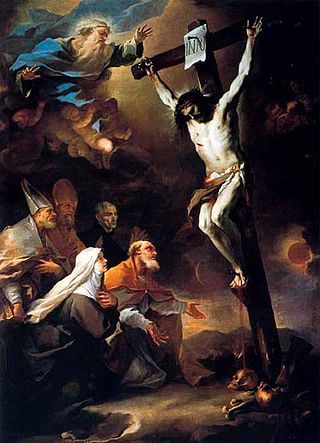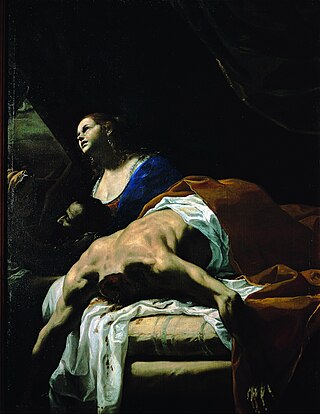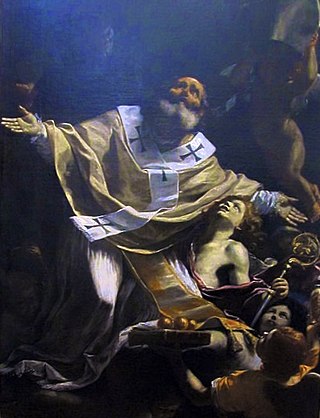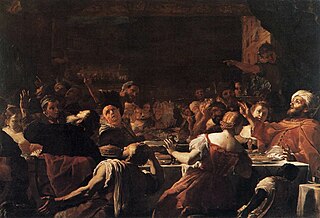The Salimbeni Prize is awarded by the Fondazione Salimbeni per le Arti Figurative of San Severino Marche to honour excellence in the writing of art history on an Italian subject. The Premio Salimbeni was established in 1983.

Antonio Solario, also known as Antonio de Solario or da Solario and sometimes by the nickname Lo Zingaro, was an Italian painter of the Venetian school, who worked in Naples, the Marche and possibly England. His career is obscure, largely pieced together from surviving works, and at one time his existence was doubted.

Giovanni Battista Caracciolo (1578–1635) was an Italian artist and important Neapolitan follower of Caravaggio. He was a member of the murderous Cabal of Naples, with Belisario Corenzio and Giambattista Caracciolo, who were rumoured to have poisoned and disappeared their competition for painting contracts.

Mattia Preti was an Italian Baroque artist who worked in Italy and Malta. He was appointed a Member of the Order of Saint John.

Castel Nuovo, often called Maschio Angioino, is a medieval castle located in front of Piazza Municipio and the city hall in central Naples, Campania, Italy. Its scenic location and imposing size makes the castle, first erected in 1279, one of the main architectural landmarks of the city. It was a royal seat for kings of Naples, Aragon and Spain until 1815.

Francesco de Mura was an Italian painter of the late-Baroque period, active mainly in Naples and Turin. His late work reflects the style of neoclassicism.

Salvatore Fergola was an Italian painter, mainly of landscapes or vedute in and around his native Naples. He is considered an exponent of the School of Posillipo.

Casa Cosmana Navarra is a 17th-century aristocratic townhouse in Rabat, Malta. The building belonged to Cosmana Navarra (1600-1687), for whom it is named until date, who was the main benefactress of the rebuilding of the Rabat parish church of St. Paul. The house is found in front of the parish church opposite the Wignacourt Museum. Most of the building was converted into a restaurant, namely the Ristorante Cosmana Navarra.

Saint George on Horseback is an oil painting by Mattia Preti painted in 1658. It is the altarpiece of the Chapel of the Langue of Aragon in St. John's Co-Cathedral, Valletta, Malta. The painting was Preti's first work in Malta, and it is regarded as one of his masterpieces and one of the best examples of Neapolitan Baroque art.

Saint Sebastian is an oil on canvas painting by Italian artist Mattia Preti, created c. 1657. It represents Saint Sebastian, and is held in the National Museum of Capodimonte, in Naples.

The Patron Saints of Naples Adoring Christ on the Cross is a 1660-1661 oil painting by the Italian Baroque artist Luca Giordano, now in the National Museum of Capodimonte in Naples. In the bottom left are the saints Baculus, Euphebius, Francis Borgia, Aspren and Candida, whilst in the top left is God the Father.

Madonna of the Rosary is a 1539 oil-on-canvas painting by the Italian artist Lorenzo Lotto, signed and dated below the Virgin Mary's feet ".L.LOTUS.MDXXXIX.".

Judith and Holofernes is an oil on canvas painting by Italian artist Mattia Preti, datable to around 1653–1656. It is held at the Museo di Capodimonte, in Naples.

The Earthly Trinity with Saints and God the Father are a pair of c.1626-c.1635 oil on canvas paintings by Jusepe de Ribera, both now in the Museo nazionale di Capodimonte in Naples. Along with the Holy Family, the main work shows Bruno of Cologne, Benedict of Nursia, Bernardino of Siena and Bonaventure.

Saint John the Baptist is a c.1653-1656 oil on canvas painting by Mattia Preti, now in the Museo nazionale di Capodimonte in Naples.

Saint Nicholas is a c. 1653 painting by Mattia Preti, the first work he produced after moving to Naples and showing the three gold balls which are a traditional attribute of the saint. It is now in the Museo nazionale di Capodimonte in the same city. He also produced a larger version of the work in 1657 which is now in the Pinacoteca civica in Fano, with an early copy after the Capodimonte version now in the church of Santa Teresa degli Scalzi in Naples.

The Banquet of Absalom is an oil on canvas painting by Mattia Preti, created in c. 1660–1665, now in the Museo nazionale di Capodimonte in Naples. It illustrates a passage from chapters 13 and 14 of 2 Samuel in the Old Testament, in which King David's son Absalom avenges the rape of Absalom's sister Tamar two years earlier by inviting her rapist Amnon to a feast, getting him drunk and then killing him.

Belshazzar's Feast is a circa 1660-1665 oil on canvas painting by Mattia Preti, now in the Museo nazionale di Capodimonte in Naples. It shows a scene from chapter 5 of the Book of Daniel.

The Return of the Prodigal Son is a 1656 oil on canvas painting by Mattia Preti, now in the Museo nazionale di Capodimonte in Naples.

The Return of the Prodigal Son is a c. 1658 oil on canvas painting by Mattia Preti, now in the Royal Palace of Naples.



















